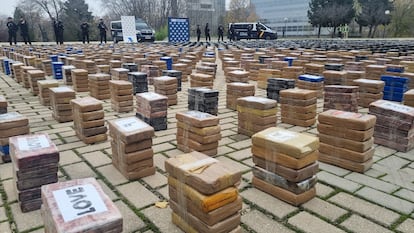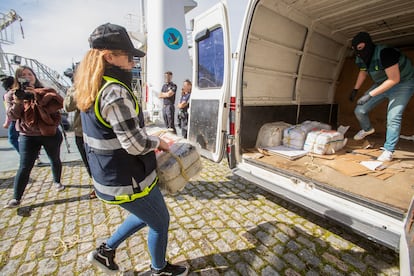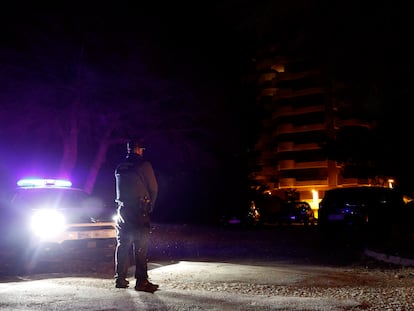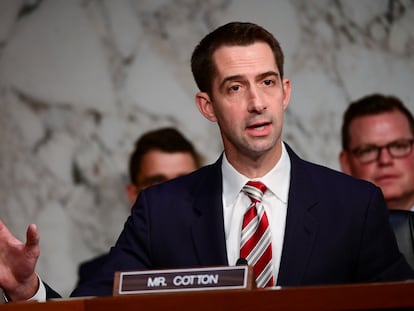Drug trafficking, more powerful than ever, floods Europe with cocaine
In 2023, 100,000 kilos of cocaine were seized in Spain. According to police sources, this was more than double what was confiscated the previous year. The reasons for the drug avalanche are on the other side of the Atlantic


Over the past year in Spain, cocaine seizures have broken all historical records. “We’re going for 100,000 kilos… more than double what was [intercepted] in 2022,” affirm sources from the National Police and the Civil Guard, the organizations responsible for the fight against drug trafficking. The Ministry of Interior still hasn’t released official reports related to that period of time. Spain – which is already the EU’s biggest cannabis-producing country – ”is flooded with cocaine, like all of Europe,” the same sources warn.
The consequences of the drug boom are beginning to be seen very clearly in neighboring countries such as Sweden, where the government put the army on the streets last September to stop the wave of murders linked to gang rivalries. Or in the Netherlands, where the 20-year-old Princess Catharina-Amalia — next in line to the throne — had to limit her movements. She received increased security after being threatened by known members of the Mocro Maffia, a vast network of criminal organizations whose reach has expanded globally.
A few weeks ago, two shootings in the center of Brussels left one man dead and a woman injured, when she was run over in the car in which some suspected drug traffickers were fleeing. Also, in the Spanish city of Barbate, the pilot of a drug boat — nicknamed El Cabra (“the goat”) — rammed a Civil Guard vessel, killing two agents and injuring four others on February 9.
Whether it be from local police reports or from international organizations such as the United Nations, those who are fighting this scourge, which threatens the stability of states, have made their message clear: “Drug trafficking is stronger than ever” and “there are more drugs than ever.” Or, as Spain’s Anti-Drug Prosecutor Rosana Morán stated in her 2023 report, in reference to the omnipresence of narcotics: “Everywhere, everything, everyone.”
To look for the reasons for the large amount of drugs that are entering Europe — and to understand what has led to the establishment of new, increasingly violent criminal groups — it’s necessary to look to the other side of the Atlantic. That’s where the mainly maritime routes begin, through which tons of cocaine are being trafficked.
Today, one of the hottest spots for drug trafficking on a global scale is Ecuador, which is experiencing a serious security crisis. On March 31, 2023, half-a-dozen armed men entered the vacation home of Ecuadorian businessman Rubén Cherres, in Santa Elena (in far western Ecuador). They tortured and killed him, along with his girlfriend, a friend and his security guard. At the time, Cherres was the target of an investigation by the Ecuadorian Prosecutor’s Office, which linked him to the brother-in-law of the then-president of the country, Guillermo Lasso, and to Albanian drug trafficking groups, which have operated in the Latin American country since 2009.
“The Albanians saw a great business opportunity: instead of fighting with the cartels in the traditional coca leaf producing countries (Colombia, Bolivia and Peru), they chose to buy the drug directly from them and send it to Europe from the port closest to the border: Guayaquil,” explains Antonio Martínez Duarte, head of the Drugs and Organized Crime Unit of Spain’s National Police (UDYCO). “They acquired large banana and fruit export companies as a cover to ship tons of cocaine throughout Europe,” he adds. Spain — specifically the cities of Valencia, Barcelona and Algeciras, where members of the so-called Balkan Clan have settled — is currently a major gateway for drugs.
“In Europe, the ports of Antwerp and Rotterdam are of concern: [they’re] the two main ports where cocaine arrives from Latin America. But Valencia is in third place,” points out Morán.
Over the course of the year that she’s been in office, Morán has promoted international cooperation measures, which are crucial when it comes to combating these transnational crimes. Given the backlog that these cases generate in the investigative courts of the small towns in which the unloading occurs, Morán has advocated for “the creation of specialized courts in the provinces [of Spain] that bear the most pressure from drug trafficking, [as well as] the expansion of the powers of the National Court,” as she outlines to EL PAÍS by phone. This, she explains, will allow her to take on the bigger issues, which have complex ramifications. Morán points out how, at the moment, there are judges from small local courts who have to take on cases involving dozens of detainees linked to international organized crime… while also overseeing matters such as divorce proceedings.
“The success of the fight against drugs doesn’t end with the increase in arrests and seizures [of illicit cargo], but with the convictions of the perpetrators and the recovery of the profits obtained,” the prosecutor emphasizes. For Morán, the problem of drug trafficking “also belongs to [the Ministry of] Justice.” The number of detainees for narcotics charges hasn’t stopped growing in Spain: 18,193 in 2018; 20,441 in 2019; 20,599 in 2020 (the main year of the coronavirus pandemic); 22,968 in 2021 and 24,117 in 2022, according to the latest records provided by the Ministry of the Interior.
Two weeks ago, the National Police dealt another blow to the Albanian mafia installed in Valencia, with 17 arrests and the seizure of 850 kilos of cocaine. In 2023, nearly 9,000 kilos were seized in the Valencian port from members of groups that are predominantly made up of Albanians, giving rise to unprecedented images of drugs being displayed in police stations. All of the cocaine in the latest raid came from Ecuador.
According to reports from the United Nations, Europol, the Spanish Prosecutor’s Office and the National Police, the port of Guayaquil — despite the fact that Ecuador isn’t a cocaine-producing country — is now one of the main departure points for the tons of cocaine that are flooding Europe.
Two weeks ago — almost a year after those murders in Santa Elena — the Spanish National Police carried out Operation Pampa, alongside their Ecuadorian counterparts. Thirty-two people were arrested in total: 13 in Spain, 18 in Ecuador and one in the United Kingdom. At the moment, Ecuador requires visas for Albanian citizens, while most of the country lives under a curfew due to crime. This is after the assassination (in broad daylight) of Ecuadorian presidential candidate Fernando Villavicencio, who was shot dead on August 11, 2023, and the murder of anti-corruption Prosecutor César Suárez this past January 17.
Among those arrested in the recent operation was a “high value target” named Dritan Gjitka, an Albanian national. Gjitka’s main business partner — also detained — was an Argentine-Italian citizen living in Marbella, Spain. He was allegedly importing bananas from Ecuador… in addition to 4,000 kilos of coca per month. The value of what was seized in the 22 searches carried out in Spain is striking: €500,000 in cash, an automatic pistol and 12 high-end vehicles. Additionally, 17 properties worth about €12 million ($13.2 million) were embargoed, according to a police report. “Gjitka is a guy who, by phone, closed weekly 6,000-kilo shipments from Colombia to Ecuador,” sources in the investigation point out.
The latest report from the United Nations Office on Drugs and Crime (UNODC) spoke of a record production of pure cocaine in 2020: close to two million kilos. But researchers say that, in the last three years, this figure “has grown exponentially.”
“The value of a kilo of coca placed in a Guayaquil container can be around $2,500-$3,000,” says a Civil Guard official from the Organized Crime Unit. “But that same kilo — in the container in Valencia or Algeciras — is already worth $30,000,” he adds. The profit margin is huge. “[We think] that a Galician boss sent €36 million ($39 million) to Cúcuta (Colombia), which he must have stored somewhere, in suitcases,” a UDYCO agent says, underlining the immense economic capacity that many drug lords have.
According to experts, the incessant production of coca plants in Colombia and other coca-producing countries — consented to by governments incapable of offering better alternatives to the millions of people (including both farmers and workers in all kinds of ad hoc service companies) who make a living from the crop — has generated this unprecedented surplus of cocaine on the market. The price per kilo in Europe has fallen from $43,000 to $32,500 over the last decade. “There’s a lot of cocaine and it’s very cheap,” experts point out. And crop output continues to expand, even at the cost of deforesting the Amazon with the consequent climate impact.
In 2020, the decryption of the drug traffickers’ mobile communication channels — such as Encrochat or Sky-Ecc — exposed their activities and modus operandi. “It opened all of our eyes,” National Police and Civil Guard officials agree. “There were things that we intuited… but we discovered the levels of cooperation and collaboration of the different organizations. [They’re] truly multinational crime companies, with delegates halfway around the world and a network of contacts and services in each place,” a Civil Guard commander sighs.
“We also discovered the violence with which they operate: we saw the backs of trucks in the middle of a forest in Holland converted into torture centers: [they were engaged in] beheadings, burying people alive…” a National Police commander recalls. All of this information came from the massive surveillance operations, which the drug lords’ big law firms are now trying to nullify, arguing that said investigations constituted an invasion of personal privacy. So far, the defense isn’t having much success.

These interventions also revealed corruption, with the ports as the main focus. “The different [ways in] which containers serve to transport cocaine require complicity among port workers, which is a trigger for corruption. This also affects customs workers and state security forces and [institutional] bodies,” Morán writes, in the report filed by the Prosecutor’s Office.
While the big bosses of criminal organizations hold their lavish business dinners everywhere from Dubai to Istanbul, they continue to use Spain’s Costa del Sol “as a refuge” or “a rest stop with great possibilities for money laundering,” according to experts. The National Police, Civil Guard and Prosecutor’s Office are working to create spaces for meeting and coordinating with their counterparts in Latin America, to adapt to the functioning of the international mafias.
There are already Joint Investigation Teams (JIT) within the National Police, with liaison agents who transfer information to other European countries. And the Anti-Drug Criminal Intelligence Center (CICA) has been launched, with financing from the European Commission, through the International and Ibero-American Foundation for Administration and Public Policies (FIIAPP), which has delegates from all Latin American countries affected by drug trafficking, as well as a representative from the UAE. For its part, the Spanish Prosecutor’s Office is attempting to expedite all procedures in coordination with the Network of Anti-Drug Prosecutors of Ibero-America (REFAI).
“The fight is still too unbalanced,” the agents acknowledge, many of whom confront drug traffickers in the same places where they live with their families. “The pressure is brutal,” say those who are stationed in hot areas, such as La Línea de la Concepción in the Spanish province of Cádiz, or Punta Umbría, in the province of Huelva. If there’s something that characterizes organized crime, it’s certainly “the flexibility [and] its ability to adapt,” researchers point out.
For this reason, hashish routes are no longer just for hashish: the logistics and infrastructure created are also used to introduce cocaine into the European markets. This is reflected in the 2023 data provided by the Prosecutor’s Office: “Of the total number of drugs seized in [the region of] Andalusia in 2022, 50% were of hashish and 78% were of cocaine, seizures of which have increased by 78.4% in the region.” The drug boats also move from Huelva to Portugal, “taking advantage of the border and that these small vessels aren’t prohibited in the neighboring country.” Just two weeks ago, the Civil Guard intercepted a drug boat that had set sail from Huelva, bound for a point on the high seas. Around 4,350 kilos of cocaine were seized, 500 miles from the Canary Islands, its final destination.
Concern is expanding as criminal groups gain ground. Sweden has gone from being a quiet country with an exemplary quality of life and enviable public education to enduring more than 50 executions each year in cities and towns, where children as young as 13 have been caught carrying large quantities of drugs in their school backpacks. The Netherlands has seen how drug traffickers corrupted the operators of its ports in Rotterdam and Antwerp, getting them to open and close containers at will, just by making a phone call. And, in Marseille, the so-called Mocro Maffia wreaks havoc on the streets, while traffickers are acting more impulsively and brutally in Spain.
The agents and institutions that fight against drug trafficking warn about the risk of reaching situations of violence similar to those in neighboring countries. They warn that the devastating fentanyl that travels along the drug routes that link Mexico with the United States “will arrive [in Europe] sooner rather than later.” Experts emphasize that this is a crime against public health, which overwhelmingly impacts mental health: “The majority of young people who are [admitted to hospital] for psychiatric reasons have a history of drug consumption behind them.”
Sign up for our weekly newsletter to get more English-language news coverage from EL PAÍS USA Edition
Tu suscripción se está usando en otro dispositivo
¿Quieres añadir otro usuario a tu suscripción?
Si continúas leyendo en este dispositivo, no se podrá leer en el otro.
FlechaTu suscripción se está usando en otro dispositivo y solo puedes acceder a EL PAÍS desde un dispositivo a la vez.
Si quieres compartir tu cuenta, cambia tu suscripción a la modalidad Premium, así podrás añadir otro usuario. Cada uno accederá con su propia cuenta de email, lo que os permitirá personalizar vuestra experiencia en EL PAÍS.
¿Tienes una suscripción de empresa? Accede aquí para contratar más cuentas.
En el caso de no saber quién está usando tu cuenta, te recomendamos cambiar tu contraseña aquí.
Si decides continuar compartiendo tu cuenta, este mensaje se mostrará en tu dispositivo y en el de la otra persona que está usando tu cuenta de forma indefinida, afectando a tu experiencia de lectura. Puedes consultar aquí los términos y condiciones de la suscripción digital.
More information
Archived In
Últimas noticias
Maduro pleads not guilty before the federal court in New York: ‘I am still the president of Venezuela’
A new test can detect Alzheimer’s from a finger prick
UN team enters Sudanese city of El Fasher after paramilitary massacre: ‘It’s like a ghost town’
A recipe for resistance: Indigenous peoples politicize their struggles from the kitchen
Most viewed
- Gilles Lipovetsky: ‘If you want to live better and fall in love, take Prozac, don’t look to philosophy’
- Alain Aspect, Nobel laureate in physics: ‘Einstein was so smart that he would have had to recognize quantum entanglement’
- Alvin Hellerstein, a 92-year-old judge appointed by Bill Clinton, to preside over Maduro’s trial in New York
- Why oil has been at the center of Venezuela-US conflicts for decades
- Maduro’s downfall puts China’s relationship with Venezuela to the test










































